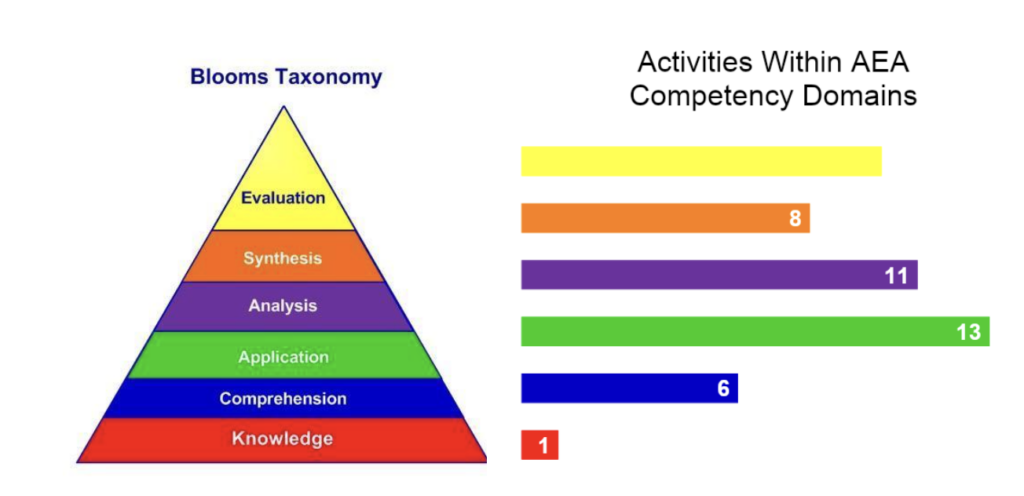Hello! I am Dr. Jessica S. Krim, and I joined Goshen Consulting as a researcher in June of 2023. My background is in STEM Education and Teacher Education, and I’ve been involved in these fields in various roles since before the internet. My career transition from academia to an evaluation firm has faced several challenges and rewards. Below, I’ll share my thinking with you about my process of understanding my role as an evaluator.
Lessons Learned
In teacher education, an established evaluation methodology is utilized by asking about the program’s purpose: “What will learners be expected to know…. to do…. to value?” As a recovering academic specializing in teacher education, I reframe new ideas within those I already understand. When learning the AEA evaluator competencies, I made a connection between these questions and the five domains:
Domain 1: Professional Practice defines what the evaluator should know and is built upon the documents at the very foundation of AEA.
Domain 2: Methodology and Domain 4: Planning & Management detail what the evaluator should be able to do, both in completing the evaluation and managing the support structures in place to bring it to fruition.
Domain 3: Context and Domain 5: Interpersonal outline what the evaluator should value, from considering multiple perspectives to maintaining social relationships with others.
Also, within the field of education, activities within the curriculum can be evaluated by determining the level at which it asks the learner to think. A standard tool that is utilized in this process is Bloom’s Taxonomy, which categorizes the complexity of a task in ascending order:

Knowledge involves recognizing and recalling facts. We do this when we “document evaluation processes and products.”
Comprehension involves understanding what those facts mean. We do this when we “clarify diverse perspectives, stakeholder interests, and cultural assumptions” or “communicate evaluation processes and results in timely, appropriate, and effective ways.”
Application involves applying our profession’s facts, rules, concepts, and ideas. We do this when we “identify assumptions that underlie methodologies and program logic” or “coordinate and supervise evaluation processes and products.”
Analysis involves breaking down information into parts. We do this when we “monitor evaluation progress and quality and make adjustments when appropriate” or “team with others when appropriate.”
Synthesis involves combining parts to make a new whole. We do this when we “design credible and feasible evaluations that address identified purposes and questions” or “advocate for the field of evaluation and its value.”
Evaluation involves judging the value of information or ideas. We do this when we “determine evaluation questions” or “pursue ongoing professional development to deepen reflective practice, stay current, and build connections.”
An analysis of the examples provided in each domain revealed that, in descending order, the examples provided in the five domains require the following cognitive skills: application, analysis, evaluation, synthesis, comprehension, and knowledge.
Rad Resources
Other ways in which to understand your transition to evaluation within a learning lens are:
1. Use the CDC’s Evaluator Self-Assessment Tool to rate your capacity as an evaluator.
2. Get online and join the IC Topic Chats on Thursdays at noon Eastern. It’s a welcoming community for all. You can register for the IC Topic Chat sessions here.
3. Do an AEA 365 Blog topic search for areas of interest to you.
As I navigate this new professional landscape, my key takeaway is that we all bring our own sets of knowledge, skills, and dispositions to the field of evaluation, and the AEA competencies allow us to focus our efforts on common goals. I hope to continue learning from the many experts in this organization and use my experience in the education field to contribute to its collective growth.
The American Evaluation Association is hosting Goshen Consulting, an independent consulting firm. Do you have questions, concerns, kudos, or content to extend this AEA365 contribution? Please add them in the comments section for this post on the AEA365 webpage so that we may enrich our community of practice. Would you like to submit an AEA365 Tip? Please send a note of interest to AEA365@eval.org. AEA365 is sponsored by the American Evaluation Association and provides a Tip-a-Day by and for evaluators. The views and opinions expressed on the AEA365 blog are solely those of the original authors and other contributors. These views and opinions do not necessarily represent those of the American Evaluation Association, and/or any/all contributors to this site.

Hello! This is a really helpful reflection. Thank you.
Here’s an updated link for one of your rad resources. https://www.cdc.gov/national-asthma-control-program/media/pdfs/2024/09/EvaluatorSelfAssessmentv2.pdf
CDC’s main evaluation page is being updated with the release of the 2024 “refreshed” evaluation framework, so the self-assessment link got lost in the shuffle. You can check out the updated framework here: https://www.cdc.gov/mmwr/volumes/73/rr/pdfs/rr7306a1-H.pdf